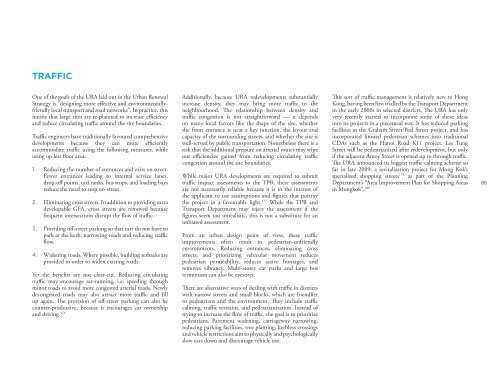Treating the Symptoms - A Critical Review of ... - Civic Exchange
Treating the Symptoms - A Critical Review of ... - Civic Exchange
Treating the Symptoms - A Critical Review of ... - Civic Exchange
- No tags were found...
Create successful ePaper yourself
Turn your PDF publications into a flip-book with our unique Google optimized e-Paper software.
TrafficOne <strong>of</strong> <strong>the</strong> goals <strong>of</strong> <strong>the</strong> URA laid out in <strong>the</strong> Urban RenewalStrategy is “designing more effective and environmentallyfriendlylocal transport and road networks”. In practice, thismeans that large sites are re-planned to increase efficiencyand reduce circulating traffic around <strong>the</strong> site boundaries.Traffic engineers have traditionally favoured comprehensivedevelopments because <strong>the</strong>y can more efficientlyaccommodate traffic using <strong>the</strong> following measures, whileusing up less floor area:1.2.3.4.Reducing <strong>the</strong> number <strong>of</strong> entrances and exits on street.Fewer entrances leading to internal service lanes,drop-<strong>of</strong>f points, taxi ranks, bus stops, and loading baysreduce <strong>the</strong> need to stop on-street.Eliminating cross streets. In addition to providing extradevelopable GFA, cross streets are removed becausefrequent intersections disrupt <strong>the</strong> flow <strong>of</strong> traffic.Providing <strong>of</strong>f-street parking so that cars do not have topark at <strong>the</strong> kerb, narrowing roads and reducing trafficflow.Widening roads. Where possible, building setbacks areprovided in order to widen existing roads.Yet <strong>the</strong> benefits are not clear-cut. Reducing circulatingtraffic may encourage rat-running, i.e. speeding throughminor roads to avoid more congested arterial roads. Newlydecongested roads may also attract more traffic and fillup again. The provision <strong>of</strong> <strong>of</strong>f-street parking can also becounter-productive, because it encourages car ownershipand driving. 176Additionally, because URA redevelopments substantiallyincrease density, <strong>the</strong>y may bring more traffic to <strong>the</strong>neighbourhood. The relationship between density andtraffic congestion is not straightforward — it dependson many local factors like <strong>the</strong> shape <strong>of</strong> <strong>the</strong> site, whe<strong>the</strong>r<strong>the</strong> front entrance is near a key junction, <strong>the</strong> layout andcapacity <strong>of</strong> <strong>the</strong> surrounding streets, and whe<strong>the</strong>r <strong>the</strong> site iswell-served by public transportation. None<strong>the</strong>less <strong>the</strong>re is arisk that <strong>the</strong> additional pressure on arterial routes may wipeout efficiencies gained from reducing circulating trafficcongestion around <strong>the</strong> site boundaries.While major URA developments are required to submittraffic impact assessments to <strong>the</strong> TPB, <strong>the</strong>se assessmentsare not necessarily reliable because it is in <strong>the</strong> interest <strong>of</strong><strong>the</strong> applicant to use assumptions and figures that portray<strong>the</strong> project in a favourable light. 177 While <strong>the</strong> TPB andTransport Department may reject <strong>the</strong> assessment if <strong>the</strong>figures seem too unrealistic, this is not a substitute for anunbiased assessment.From an urban design point <strong>of</strong> view, <strong>the</strong>se trafficimprovements <strong>of</strong>ten result in pedestrian-unfriendlyenvironments. Reducing entrances, eliminating crossstreets, and prioritizing vehicular movement reducespedestrian permeability, reduces active frontages, andremoves vibrancy. Multi-storey car parks and large busterminuses can also be eyesores.There are alternative ways <strong>of</strong> dealing with traffic in districtswith narrow streets and small blocks, which are friendlierto pedestrians and <strong>the</strong> environment. They include trafficcalming, traffic restraint, and pedestrianization. Instead <strong>of</strong>trying to increase <strong>the</strong> flow <strong>of</strong> traffic, <strong>the</strong> goal is to prioritizepedestrians. Pavement widening, carriageway narrowing,reducing parking facilities, tree planting, kerbless crossingsand vehicle restrictions aim to physically and psychologicallyslow cars down and discourage vehicle use.This sort <strong>of</strong> traffic management is relatively new to HongKong, having been first trialled by <strong>the</strong> Transport Departmentin <strong>the</strong> early 2000s in selected districts. The URA has onlyvery recently started to incorporate some <strong>of</strong> <strong>the</strong>se ideasinto its projects in a piecemeal way. It has reduced parkingfacilities at <strong>the</strong> Graham Street/Peel Street project, and hasincorporated limited pedestrian schemes into traditionalCDAs such as <strong>the</strong> Hanoi Road K11 project. Lee TungStreet will be pedestrianized after redevelopment, but onlyif <strong>the</strong> adjacent Amoy Street is opened up to through traffic.The URA announced its biggest traffic calming scheme s<strong>of</strong>ar in late 2009: a revitalization project for Mong Kok’sspecialized shopping streets 179 as part <strong>of</strong> <strong>the</strong> PlanningDepartment’s “Area Improvement Plan for Shopping Areasin Mongkok”. 18089
















